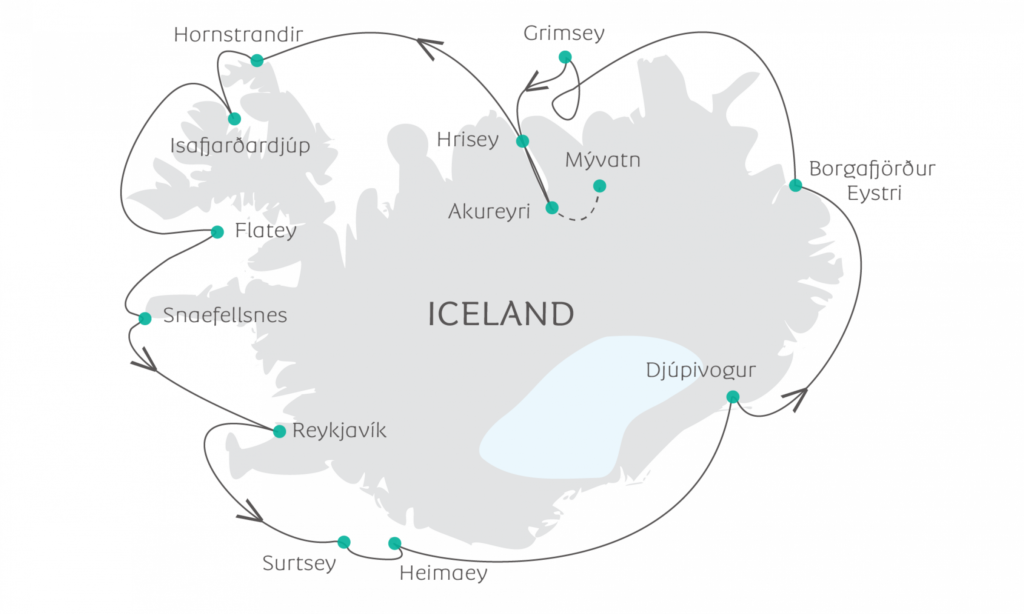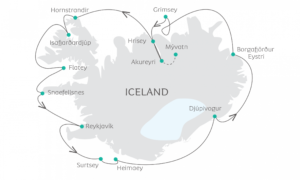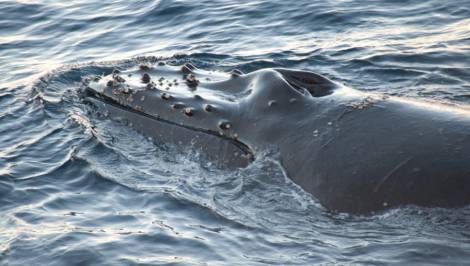ICELAND: Circumnavigation
Itinerary Map

Experience Iceland in high season, where nature displays its full splendor with bright nights and a vibrant birdlife. You will not want to go to sleep during this trip, as the landscape constantly changes and you want to keep eyes on the water in search of the whales. We can reach areas of Iceland that are not reachable on land, and in selected locations, we will land with the ship’s zodiac fleets to further explore the area. From lowlands to glacier ice, we will see the entire coast of Iceland with unforgettable experiences both on the mainland and on the many islands where seals and puffin seabirds gather.
Along the way, we will visit isolated islands, cozy little towns, stand on the polar circle and black lava sand and feel a breath of saga history.

Length of Travel: 8 days
Itinerary in Brief
Day 1: ARRIVAL TO REYKJAVÍK
Day 2: WESTMAN ISLANDS, SURTSEY AND UNESCO NATURAL HERITAGE SITES AND CITY WALK IN HEIMAEY.
Day 3: DJÚPIVOGUR AND PUFFY BIRD COLONY VISIT AT HAFNARHÓLMI.
Day 4: WHALES AT HUSAVÍK AND THE POLAR CIRCLE AT GRÍMSEY.
Day 5: HRÍSEY, AKUREYRI AND MÝVATN NATURE RESERVE (OPTIONAL EXCURSION).
Day 6-VESTFJORD, SNOWY AND DRAMATIC FJORD LANDSCAPE AT VIGUR
Day 7 -ISLAND LIFE AT FLATEY AND SNAEFELLSNES
Day 8 -REYKJAVÍK AND RETURN HOME
Detailed Itinerary
Day 1- Arrival to Reykjavic
After boarding and a welcome drink, the Expedition Leader will inform you about the voyage, the ship’s daily routines and the various security and safety procedures. Before sailing, there will be a mandatory safety drill.
The Captain takes the ship out of Reykjavík in the early evening, heading for the south coast.
Day 2 -WESTMAN ISLANDS, SURTSEY AND UNESCO NATURAL HERITAGE SITES AND CITY WALK IN HEIMAEY.
The Westman Islands were on the headlines of the world press in January 1973, when a volcano erupted in the Heimaey island. All 5,000 inhabitants evacuated, but most have now returned, and today the population is about 4,000. The Westman Islands are only 14 kilometers off the southwest coast of Iceland and consist of 15 green small islands and about 30 moorings.
When you go sailing, you can see the islands steep and grateful profiles in clear weather from a long distance. They are beautifully raised by the sea, and looking at them, one understands why an Icelandic poet would compare them with the sapphires in a silver ring.
The birdlife on these edges is unique and hosts, among other natural beauties, puffins and not least the “Queen of the Sea”, the gannet.
We start the day by passing close to one of the world’s newest islands, Surtsey. The island rose from the sea in 1963 and arrived in 2008 on UNESCO’s list of world natural heritage sites. The island is closed to the public and only researchers are allowed.
In the morning, we head to Heimaey, the only inhabited island in the archipelago, where we can see the recently excavated houses from the outbreak in 1973.
After an exciting day at Heimaey, we set the course to the southeastern corner of Iceland on the edge of Vatnajökull National Park.
Day 3 - DJÚPIVOGUR AND PUFFY BIRD COLONY VISIT AT HAFNARHÓLMI.

During the night, we sail along the southern coast of Iceland, dominated by Vatnajökull, Iceland’s largest glacier. In the morning we will make a call in the small, cozy port town of Djúpivogur.
Sheltered, but still very assessable from the ocean, the port is actually one of the oldest in Iceland, and the people from Djúpivogur take great pride in preserving some of the old houses. The town attracts creative folks and the art exhibitions are worth a visit, not least the permant Eggin i Gleðivík, 34 oversized bird eggs, carved out of granite. The Cultural Centre is located in the beautiful red timber house, Langabúð, and opposite this on the other side of the small harbor is the old Hotel Framtid.
An optional excursion is available from Djúpivogur by Super Jeeps, the work horse in modern Iceland.
In the afternoon, we re-embark Ocean Atlantic and continue north along the dramatic coastline of the east fjords. The area has the lowest population in Iceland, and fishing is the big business. One of the fjords we’ll pass is Mjóifjörður, which means the narrow fjord, flanked by high mountains with steep cliff sides and numerous waterfalls.
By mid-evening we reach the fjord Borgarfjörður Eystri. Our destination is the small island of Hafnarhólmi, now connected to the mainland by a narrow pier. This little hilltop might well be the best place to observe the fascinating puffins. The birds arrive to Hafnarhólmi from their winter stay in mid-April, and nest on rock shelves or in the tufty grass slopes completely carefree from the many bird watchers that pass daily a few meters away on the wooden trails built into the hill. As well as the puffins, eiders, fulmar and kittiwakes breed here on Hafnarhólmi.
Day 4-WHALES AT HUSAVÍK AND THE POLAR CIRCLE AT GRÍMSEY.
We have seen the northeastern corner of Iceland and sail into the bay of Húsavík, known to be one of the best places to observe whales in Iceland. Many whale species have been observed in these waters, and the most likely to be seen are the acrobatic Humpbacks, the small and agile Minke, and occasionally the gigantic Blue Whale and Sperm Whale. We sail slowly around the bay with everyone’s eyes searching for these fascinating creatures.
At noon, we sail further north to the island of Grimsey and reach the northernmost point of the journey. Grímsey is located about 40 kilometers from the mainland and is the only part of Iceland, with an Arctic designation. The Polar circle crosses the island at 66 ° 33 ‘N, and gives the island one full day of 24-hour sunlight – on June 21st! We are well into July, but will still experience fair nights on our voyage.
Over 100 inhabitants reside in the little rocky island, all living close to the harbor in the only city in the island. The fishing banks in the surrounding seas make the economy flourish, the port is expanded, and there is a small airport with daily flights to the mainland and the school for the children. The island has been inhabited right back from the settlement of Iceland and is mentioned in the sagas as an important land, rich in fish and birds.
The seabirds far exceed the number of inhabitants on Grímsey, and bird cries can be heard 24 hours a day over the bright Arctic summer. Up to 36 different species breed on the island and have their nests on the rocks. One of Iceland’s largest tern colonies is here, and it is said that the runway must be cleared for terns before the aircraft can land.
We’ll make landing by Zodiacs during the afternoon to experience the local life and explore the island’s bird life.
Day 5-HRÍSEY, AKUREYRI AND MÝVATN NATURE RESERVE (OPTIONAL EXCURSION).
During the night and early morning, Ocean Atlantic cruises through one of Iceland’s longest fjords, Eyjafjörður, cutting south into the land from the north coast. Sitting astride in the middle of the fjord, Hrísey is home to 200 islanders, and after Heimaey, is the second largest island off the coast of Iceland. We’ll make a morning call by our Zodiacs into the small town on the south point of the island, and enjoy an easy stroll through the settlement and into the outlying grass plains. As hunting has been prohibited for many years, birdlife is unusually rich. Especially ptarmigans and eiders are ubiquitous.
We continue the voyage a few miles further south to reach the beautiful city of Akureyri, where we disembark just after lunch. The climate of Akureyri is unique in these latitudes, with many more hours of sunshine and higher temperatures than the rest of Iceland.
Akureyri is a center of trade and culture and is Iceland’s second largest city. With the emerging educational environment, the many cultural events and the big fishing industry, Akureyri grows steadily, with more Icelanders – and tourists – heading to the north coast’s sunshine city.
Just stroll around town and enjoy the lively atmosphere with cozy cafés and great restaurants, as well as lush gardens and the splendid view from the city church, Akureyrarkirkja.
Or join us for a five-hour excursion to fabulous Goðafoss & Lake Mývatn.
Day 6-VESTFJORD, SNOWY AND DRAMATIC FJORD LANDSCAPE AT VIGUR
The west fjords offer one unforgettable experience after another. We start the morning sailing along the coast of Hornstrandir, the northernmost part of the West Fjords. From here, there are only 300 kilometers to the eastern coast of Greenland. In 1975 the area was converted into nature reserves, and currently has some of the strictest rules to protect the peculiar and fragile nature. Along the coast, there are good opportunities to see whales and seals, and the mountainside is alive with the rich bird life. We continue into Hornvik Bay, which is considered one of the most beautiful places in Iceland, to see two of the largest bird cliffs in Europe where millions of seabirds breed.
In the afternoon, we sail further into Isafjardardjúp, and take a walk on the island of Vigur at the mouth of Hestfjördur to enjoy the view of the steep mountains and see the terrific aerobatics of the Arctic Terns.
A local guide will takes us on a walk around the island, and coffee and light refreshments will be served in the local café.
In the evening, we leave Isafjardardjúp and sail towards the southern part of the West Fjords.
Day 7 -ISLAND LIFE AT FLATEY AND SNAEFELLSNES
We have passed Iceland’s westernmost point, the huge bird cliffs of Latraberg early in the morning. After breakfast we make landing at island of Flatey, the only one of Breidafjördur’s numerous islands inhabited all year. However, most of the colorful houses are holiday homes only used in the summer months.
The island has a rich part in the history of Iceland and previously had great cultural significance when in the 1100s an Augustine monastery was at the highest point of the island. Later, the island became a focal point for trade with the northwestern part of Iceland when the Danish king appointed Flatey as an official trading station in 1777. Until the end of the last century, the population grew until the island almost overcrowded in comparison to its small size. Today, only two inhabited farms are left.
In the afternoon, we sail along the 100-kilometer long peninsula Snaefellsnes, which with its dramatic cliff coast, hardened lava floods, sandy beaches and volcanic peaks, is a picture of Iceland in mini-format.
We round the nest on the peninsula and can enjoy the view of the nearly 1,500-meter-high snow-covered volcano Snæfellsjökull, which was the center of Jules Vernes novel “The journey to the center of the earth”. The volcano with the almost perfect cone shape and the surrounding area became in 2001 the Snæfellsjökull National Park.
Day 8 -REYKJAVÍK AND RETURN HOME
In the morning Ocean Atlantic goes alongside in the port of Reykjavik. It’s time to say farewell to the crew and begin the homeward journey.


